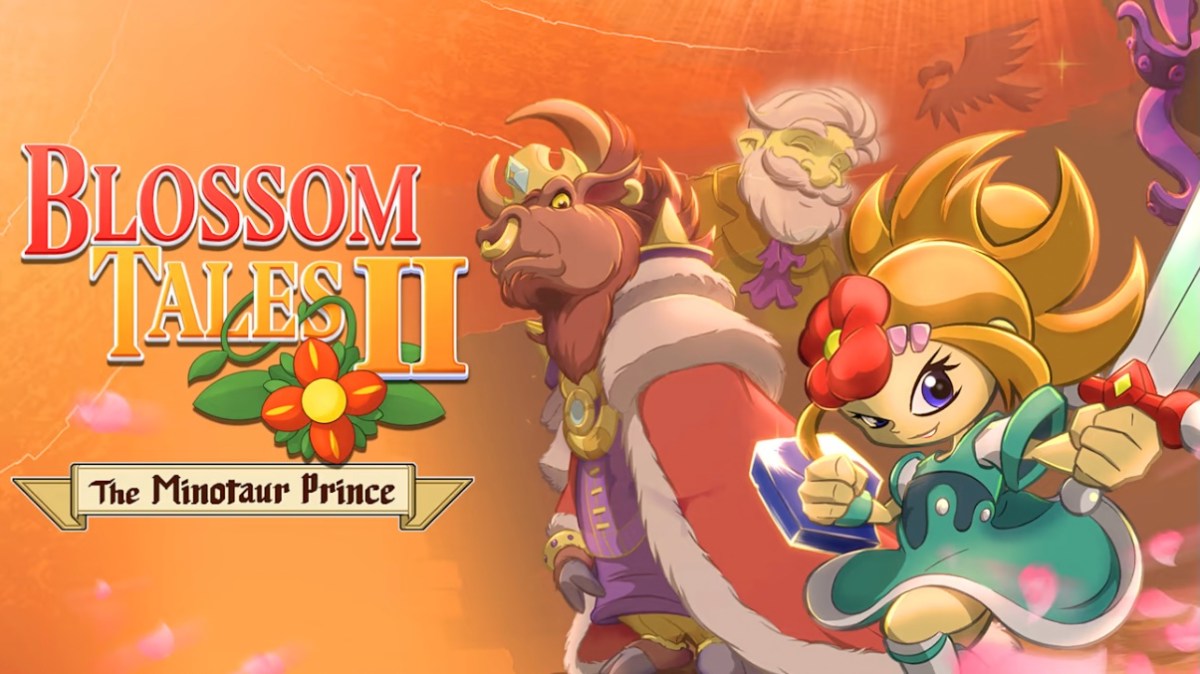Second verse, same as the first
Blossom Tales: The Sleeping King was one of the early Switch success stories that showed how vital the system would be for indie developers. After being largely ignored on PC, the game dropped on the Switch eShop in December 2017 and sold more copies on the platform in one day than in the roughly nine months it had been available on Steam. The move actually saved the fledgling indie studio, and five years later, Castle Pixel is bringing players back to the world of Lily, Chrys, and Grandpa with Blossom Tales II: The Minotaur Prince.

Blossom Tales II: The Minotaur Prince (PC, Nintendo Switch [reviewed])
Developer: Castle Pixel
Publisher: Playtonic Friends
Released: August 16, 2022
MSRP: $14.99
It is story time again for siblings Lily and Chrys who, after having an argument over a stick, are sat down by their eternally patient grandfather for another tale of danger and delights. In the first Blossom Tales, young girl Lily became hero Lily, the heroine of the tale. This time, she’s back at the center of the adventure with Chrys along for the ride. The Minotaur Prince’s story begins with a competition for glory that ends when an enraged Lily inadvertently summons the fabled Minotaur King, who whisks Chrys away to his labyrinth fortress for a little Hook-like bonding. To save her brother, hero Lily must brave multiple dungeons, angry pirates, and a horde of hostiles looking to cut her adventure short.
If you know nothing of the Blossom Tales series, just picture The Legend of Zelda: A Link to the Past and you’re about 95% of the way there. Hero Lily’s journey will take her back and forth across this largely unremarkable land, collecting heart pieces and completing side quests. The centerpiece of her adventure is the series of well-designed dungeons she’ll fight her way through. These are largely a step up from its predecessor with good enemy variety, light-but-never-taxing puzzles, and impressive sub-boss and boss battles.
Also a step up from the first game: the soundtrack. Composer Visager absolutely understood the assignment here, fashioning a mellifluous suite to accent hero Lily’s quest.
A few changes have been made to how the game plays compared to The Sleeping King. Hero Lily is a lot less slippery here, but she’s also slower. Her roll-dash can help compensate for this lack of speed, but, like every tool in her arsenal that isn’t her sword, this is tied to an energy meter that quickly depletes in the early hours. Also new to the fun is potion crafting, which you’ll need to partake in a few times as you won’t find health potions in the wild anymore.
I encountered small issues here and there, such as its poor inventory management, but they never proved invasive enough to push me away from the game. In fact, The Minotaur Prince sunk its hooks into me so deeply that I played through the entirety of it in a single sitting. That’s how captivating this game is. And I can just imagine how much more engrossing a possible third Blossom Tales game could be if the developers tried to inject some originality into the formula.
Baby, I swear it’s deja vu
As it did The Sleeping King, developer Castle Pixel chose to stay in the comforting shade of The Legend of Zelda’s shadow for The Minotaur Prince rather than forge its own path. Most everything you encounter in this game, from the tools you unlock to the songs you play, can be traced directly to one of Link’s adventures over the past 30 years. Obviously, most games that can be considered Zelda clones share some DNA with the franchise, but many also try to forge their own path. Reverie or Turnip Boy Commits Tax Evasion may not be the best entries in the Zelda-like pantheon, but they at least come to the action-adventure genre with a unique perspective. Blossom Tales would rather settle on being the poster child for Oscar Wilde’s famous quote on imitation.

And the thing is, Castle Pixel’s series actually has a great concept at its core that could further set it apart from its source of inspiration. As a story within a story, the kids Lily and Chrys will occasionally influence the tale being told. At certain points throughout the adventure, the siblings will disagree on what type of enemy just ambushed the hero Lily and you, as the player, get to decide who gets their say. It’s a fun twist on the narrative process, and while there are a few other instances of this choice mechanism coming into play, it’s still severely limited in its implementation. It might be too much to ask of a small indie team, but it would be great to see this conceit taken to its natural conclusion where the kids can influence everything from the bosses you fight to the actual layout of the land.
Despite the restrained application of its central narrative concept, Blossom Tales II: The Minotaur Prince is one of the better indie Zelda clones I’ve played. Even if it hews a bit too close to its predecessor and lacks an identity to call its own, this is a solid action-adventure game, one that makes great use of those Legend of Zelda building blocks in crafting a satisfying journey.
[This review is based on a retail build of the game provided by the publisher.]














Published: Aug 16, 2022 10:00 am